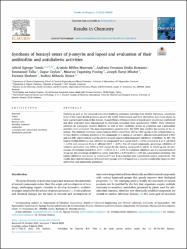Synthesis of benzoyl esters of beta-amyrin and lupeol and evaluation of their antibiofilm and antidiabetic activities
Abstract
Diabetes as well as the enhanced microbial multidrug resistance resulting from biofilm formation, constitutes some of the major health problems around the world. Triterpenoids and their derivatives have been shown to have a great contribution in this domain. A small library of benzoyl esters of lupeol and beta-amyrin was synthesized and their structures were characterized by electronic ionization mass spectrometry (EIMS). Their inhibitory potential on pathogenic bacteria biofilms, as well as their inhibitory action on alpha-amylase and beta-glucosidase activities were evaluated. The mass fragmentation patterns from the EIMS data confirm the success of the reactions. The minimal inhibitory concentrations (MIC) varied from 250 to 1000 mu g/mL in the antimicrobial activities. Biofilm inhibitory potential of the compounds on S. aureus, E. coli and C. albicans were performed at MIC and sub-MIC concentrations and the results showed concentration-dependent inhibition of biofilms. At MIC, the highest biofilm inhibition was exhibited by compound 7 on S. aureus (60.8 +/- 3.2%), compound 3 on E. coli (60.5 +/- 2.8%) and compound 8 on C. albicans (56.9 +/- 2.5%). For all tested compounds, percentage inhibition of violacein production was 100% at MIC except for the starting compounds 1 and 2. At 24.24 mu g/mL the percentage of inhibition varied from 22.9 +/- 1.2% to 42.1 +/- 1.0% for alpha-amylase inhibition and at a concentration of 10 mu g/mL the percentage of inhibition varied from 49.8 +/- 0.3% to 69.3 +/- 1.0% for beta-glucosidase inhibition. The highest inhibition was shown by compounds 7 and 8 on alpha-amylase and beta-glucosidase assays, respectively. The results show that introduction of benzoyl ester groups at C-3 of lupeol and beta-amyrin considerably improves their antibiofilm and antidiabetic poten


















